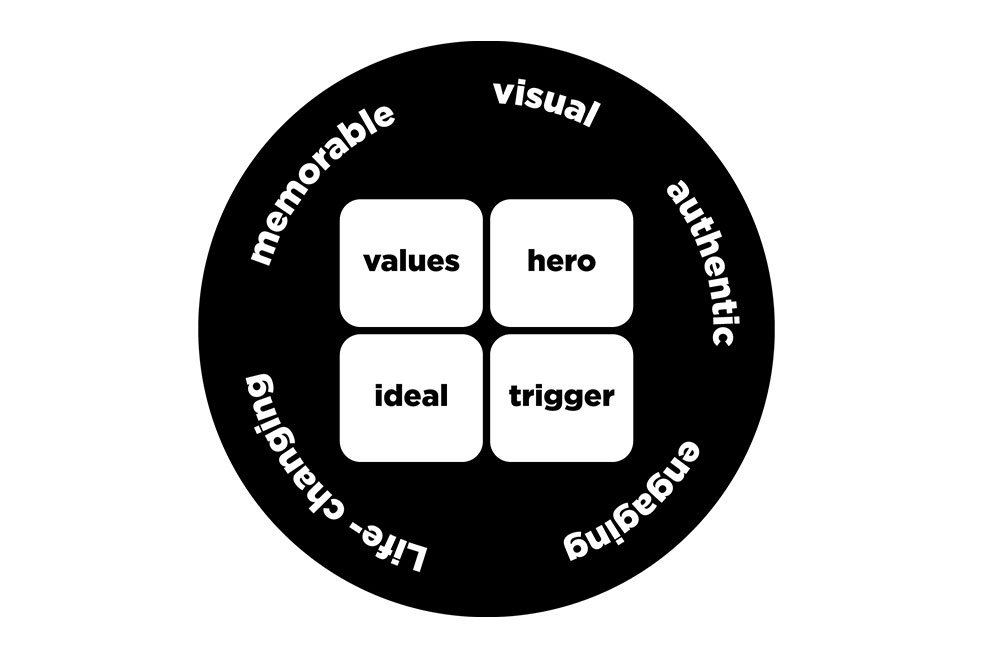Branding
Framework – Wrapping skills for compelling brand storytelling.
A framework on how to package your message into a compelling and engaging brand story.

In a world where we are flooded with content in all possible forms every single day, it is tough to stand out as an organization. Brands are in constant competition for the consumer’s attention. From endless commercial breaks and sponsored advertisements on socials to radio ads and influencer marketing. Not a day goes by without consumers being exposed to advertising. Even if they might not be aware of it. Advertising is e-very-where, and there is no escaping it.
No matter what, entrepreneurs keep innovating and keep investing tons of money into capturing the attention of their target audience, even just for a few short seconds. But how do you stand out among the masses and get eyeballs on your content? Well… storytelling, storytelling, storytelling.
(Disclaimer: but never without strategy.)
Storytelling is like putting a soul into your brand.
“Brand storytelling is the art of connecting the hearts and minds of customers to shared values and ideals of the brand.”
Storytelling is certainly not the latest fad. Ever since man could speak, he has been telling stories. Stories unite people, evoke emotions and inspire. Storytelling in terms of marketing – brand storytelling – is no different and has in recent years become a key element in the most eye-catching marketing strategies. It works damn well, if you know how to do it.
Brand storytelling is a branding technique that breathes life into your brand by telling a story that is recognizable, engaging and relevant. A story that is easy to understand will spread like juicy gossip. What’s more, your chances of success drastically increase when your story is also backed by a strong strategy. A combo of storytelling and content marketing is like that perfect cocktail that will have your mouth tingling after just one sip, leaving your target audience wanting more.
Recap. With content marketing, you strategically provide your target audience with content that responds to their needs and desires. The main goal here is to position your brand or product top-of-mind and to provide information that is convincing and decisive in generating leads, and that will encourage them to make a certain purchase.
Storytelling, on the other hand, builds – in a much more subtle way – an emotional connection with your target audience. The difference between the two is in how you approach it. Do you captivate attention with a jaw-dropping story or convince them with your expertise? Of course, you only have one goal in mind: to capture and hold the attention of the target audience.
The art of getting people wrapped up in your story.
“Human memory is story-based.”
Storytelling is not only the art of getting people wrapped up in your message, but it is also a science. Our brain loves stories, because that is exactly how our memory works. It is a collection of interlaced stories. Whenever our brain takes in new information and remembers it, this is either because we were told about it or because we read it somewhere in the form of a story. Bingo! As a brand, go all in on finding that story that will really resonate with your target audience. You will see that this will help them better absorb your message, remember it, and share it with others. Even more so, they will naturally want to be part of your brand story simply because it’s so relatable and tangible.
When brand storytelling succeeds in creating a challenge, a community and an atmosphere that consumers want to share with others and really want to be a part of, only then did we truly create a successful brand story.
The Four Five Framework: key elements for a strong brand story.
So what makes a story a strong story and how do you go about building one? The Four Five Framework – compiled by Handlangers – is a useful tool that makes building your story easier and provides an overview of all the essential elements needed for a successful brand story. It is a two-part framework, consisting of four key story elements and five required features.

Four to the core.
The inner circle represents the core of your brand story. It is important that as an organization you first look for the core of your story, much like the core of your company. This will give you a strong foundation to then really start shaping your story, including the emotions you want to convey throughout.
First things first, let’s have a look at the four key elements of your brand story:
- Hero > the main character of the story. Your target audience is always the hero in the story. Make sure that they play the leading role, no matter what. To do this, give your brand a face and a character – a personality for your target audience to identify with and to recognize themselves in. Practically, this also means that any and all content you publish has to be the ultimate tool that helps them solve their problem.
- Trigger > what gets the story started. The driver and motivation that will get your story off the ground. Often this will be a problem that you want to solve in the world or a change that you want to bring about. The trigger should provide some sort of tension in your story. No tension, no story. Again, try looking at this from the perspective of your target audience.
- Ideal > the hero’s reason for being. This is the story element that gives your target audience or hero a sense of direction and gets them to take action. Also known as the ‘raison d’être’ of your organization. Your ideal should not only have a direct link with your core business, it should also be ambitious and broad. Every organization has an impact on its stakeholders. It is important that you can define that impact and determine an ideal that has a positive influence on society. As an example, the New York Times’ ideal is: “Seek the truth and help people to understand the world”.
- Value > the uniqueness of the story. What values does your brand strongly believe in? What is most important to your brand? Brand values give color and character to your brand. Think of them as the human qualities of your brand, qualities with which your target audience can identify. They make you unique as a brand and provide guidance in everything that you, as a company, do and will do in the future.
Five to strive.
The outer circle is the packaging of your brand story, as it were. These are five features that add emotion and make your story more tangible. If your brand story has all these characteristics, you can be sure that your story will stick. You should aim to include all of the following.
A strong brand story is:
- Authentic: tell your story honestly and with feeling. No one can tell the same story as your brand, it is unique. You are the author here, make it genuine.
- Memorable: make it unforgettable. Make sure to evoke emotion and empathy, and you will see that your story will leave a lasting impression.
- Captivating: create a community and interact with them. If there is no place for your target audience within the story, then there is no reason for them to pay attention to it.
- Life-changing: leave a positive impact on your stakeholders. Change their lives by providing the best possible solution to their problem.
- Visual: humans are visual creatures, so make your story visually appealing. This is crucial in helping your audience to better interpret and remember your message. The colours, typography, logo, symbols and photography, they all contribute to building an even stronger story.
“A good brand story is a signature brand story, a once-upon-a-time narrative.”
A good brand story is a signature brand story. In other words, a story you would want to tell again and again. A story so strong that, when you share it, it will help people perceive you in a slightly different light. A story so intriguing, authentic and memorable that it almost tells itself. A story that takes its audience where you as a brand want them to go.